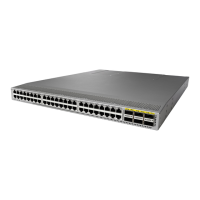CHAPTER 20
Configuring Rollback
This chapter contains the following sections:
• Information About Rollbacks, on page 197
• Guidelines and Limitations for Rollbacks, on page 197
• Creating a Checkpoint, on page 198
• Implementing a Rollback, on page 199
• Verifying the Rollback Configuration, on page 199
Information About Rollbacks
The rollback feature allows you to take a snapshot, or user checkpoint, of the Cisco NX-OS configuration
and then reapply that configuration to your switch at any point without having to reload the switch. A rollback
allows any authorized administrator to apply this checkpoint configuration without requiring expert knowledge
of the features configured in the checkpoint.
You can create a checkpoint copy of the current running configuration at any time. Cisco NX-OS saves this
checkpoint as an ASCII file which you can use to roll back the running configuration to the checkpoint
configuration at a future time. You can create multiple checkpoints to save different versions of your running
configuration.
When you roll back the running configuration, you can trigger an atomic rollback. An atomic rollback
implements a rollback only if no errors occur.
Guidelines and Limitations for Rollbacks
A rollback has the following configuration guidelines and limitations:
• You can create up to ten checkpoint copies.
• You cannot apply the checkpoint file of one switch into another switch.
• Your checkpoint file names must be 75 characters or less.
• You cannot start a checkpoint filename with the word system.
• You can start a checkpoint filename with the word auto.
• You can name a checkpoint file summary or any abbreviation of the word summary.
Cisco Nexus 3548 Switch NX-OS System Management Configuration Guide, Release 7.x
197

